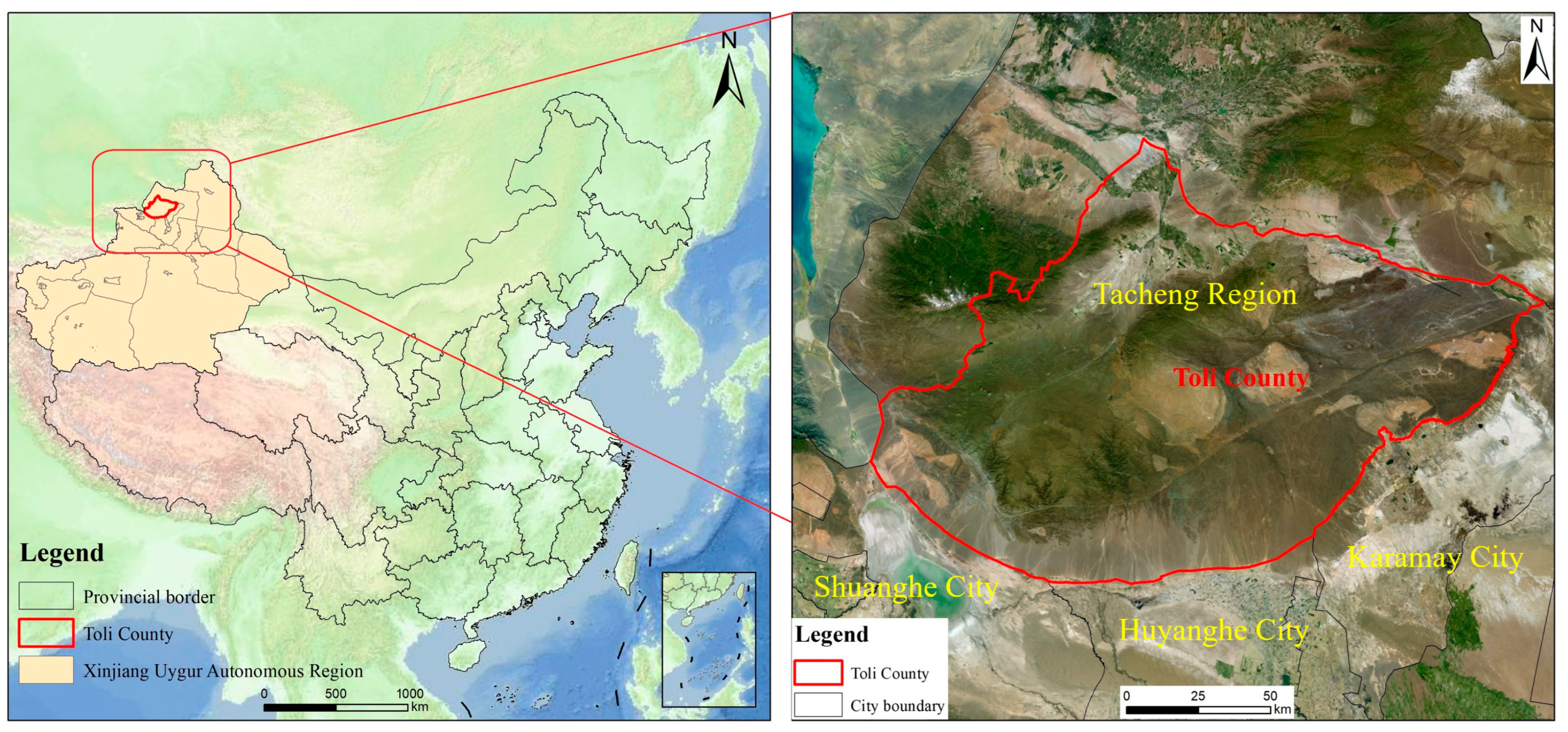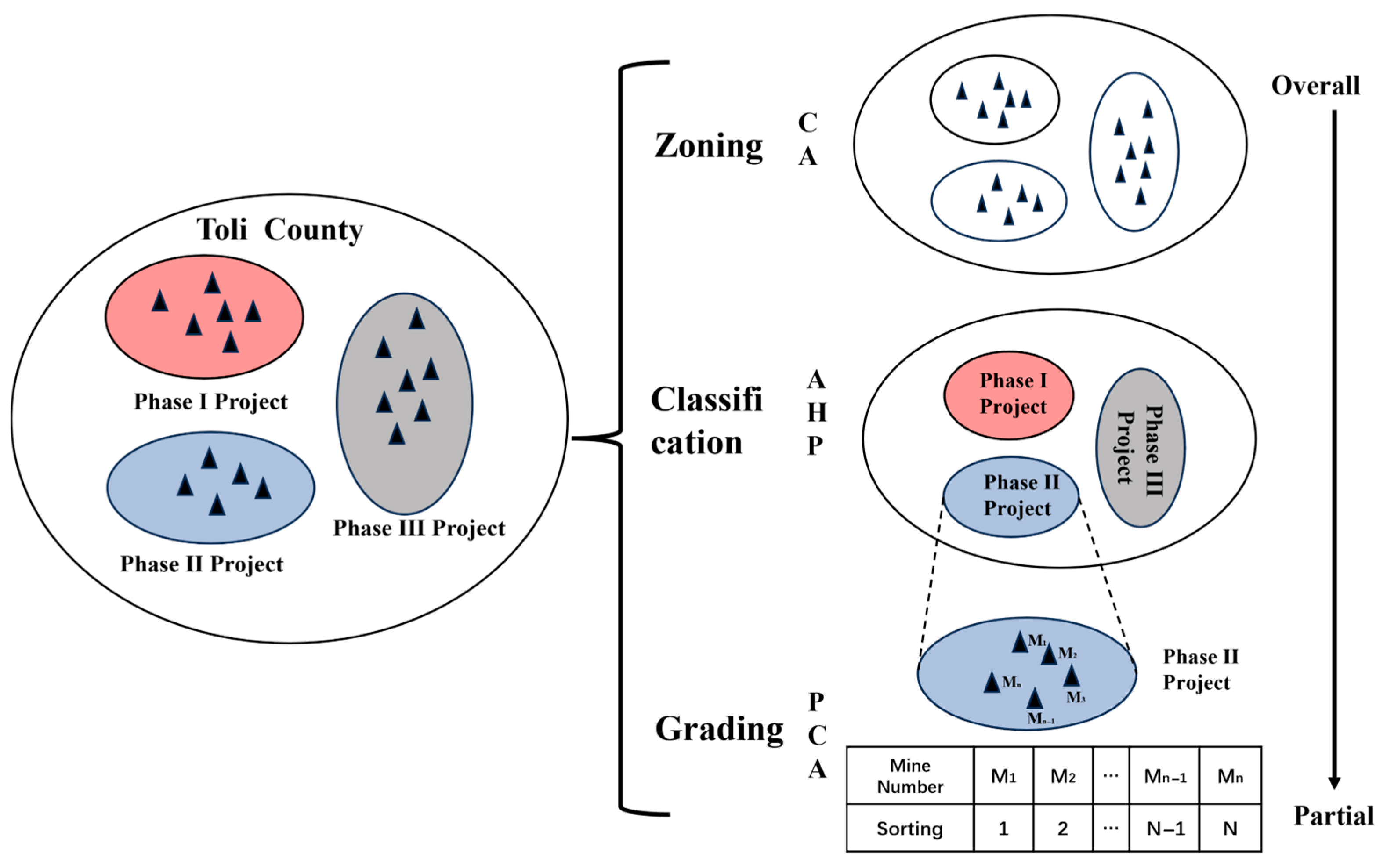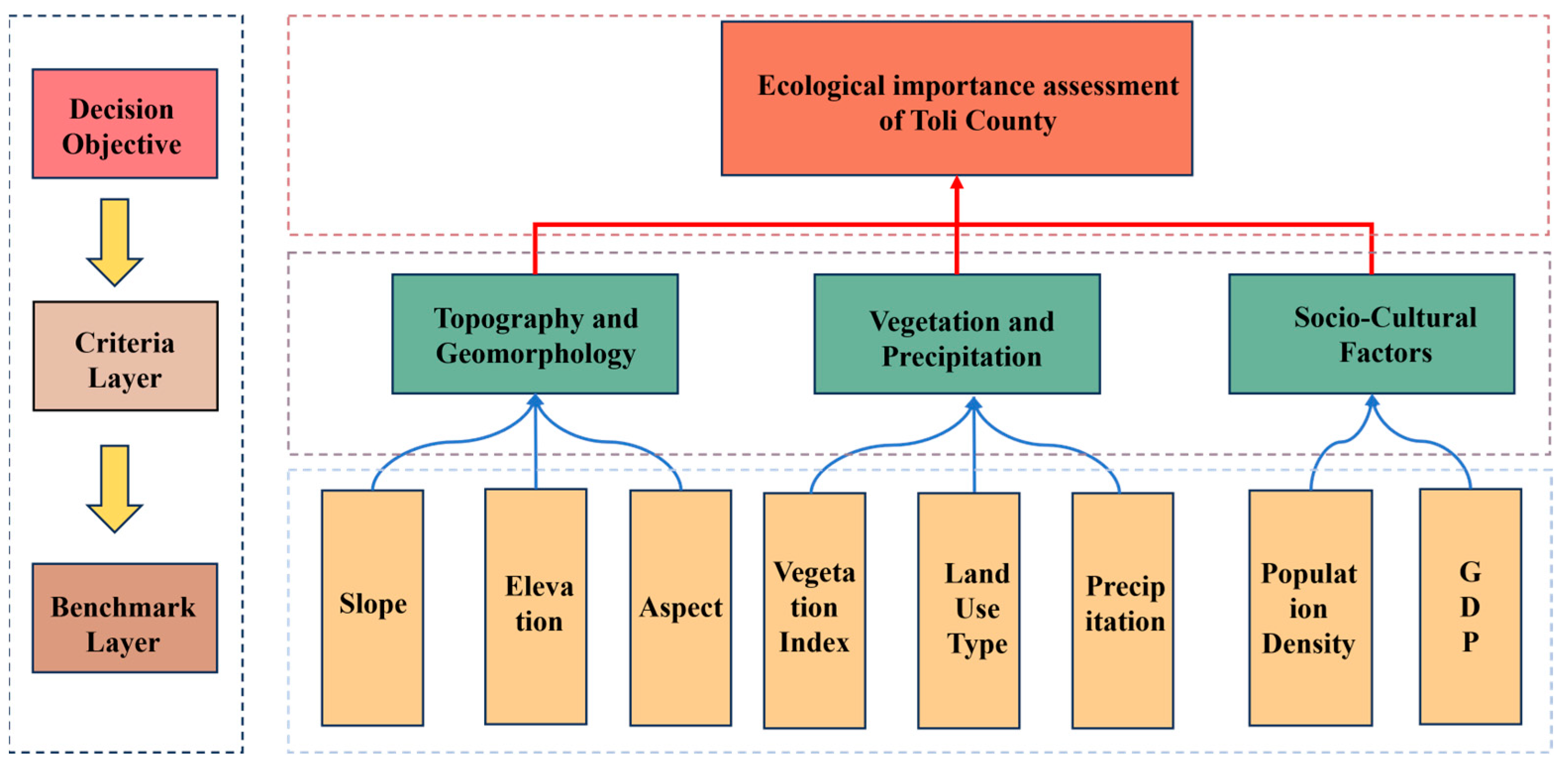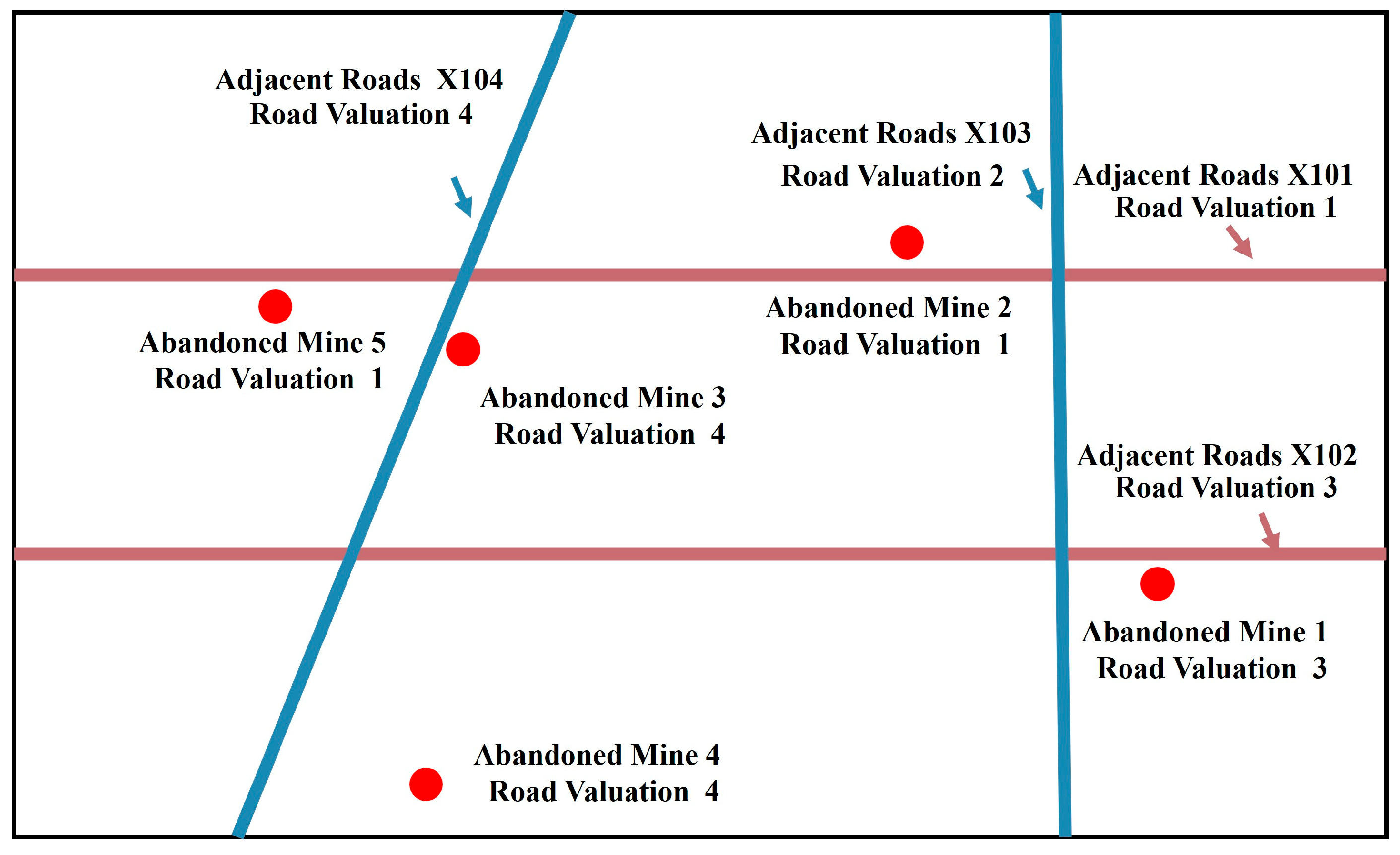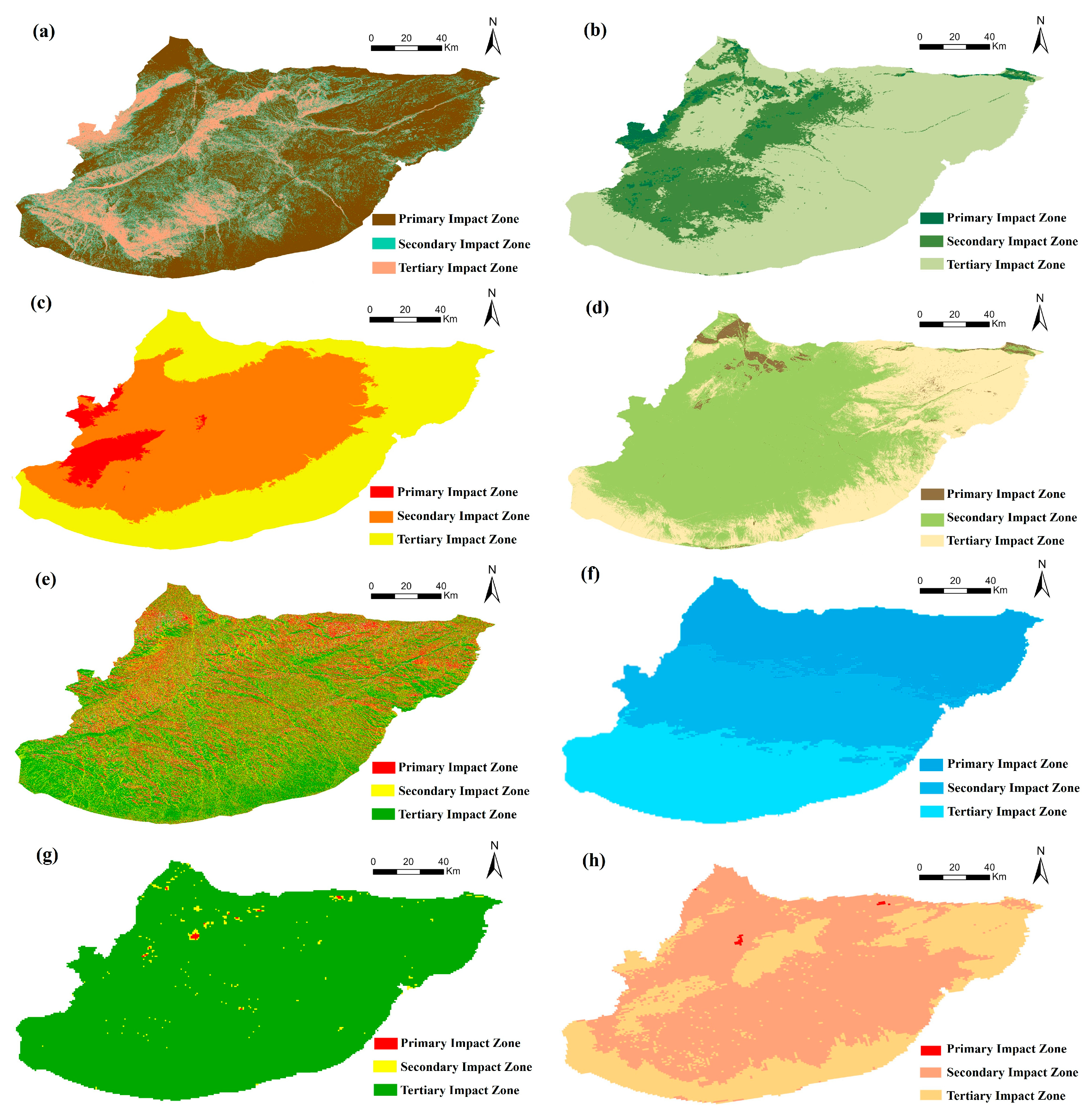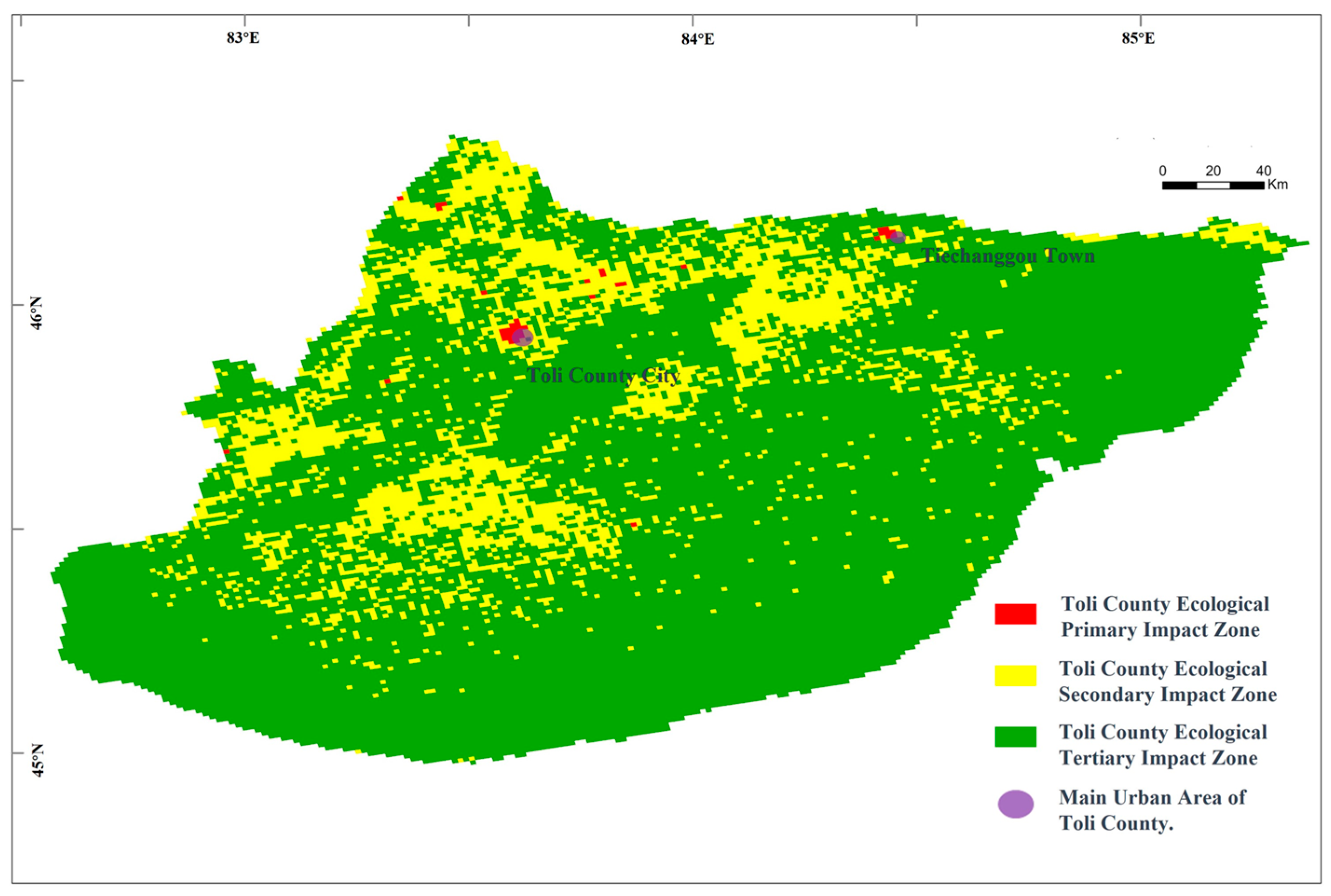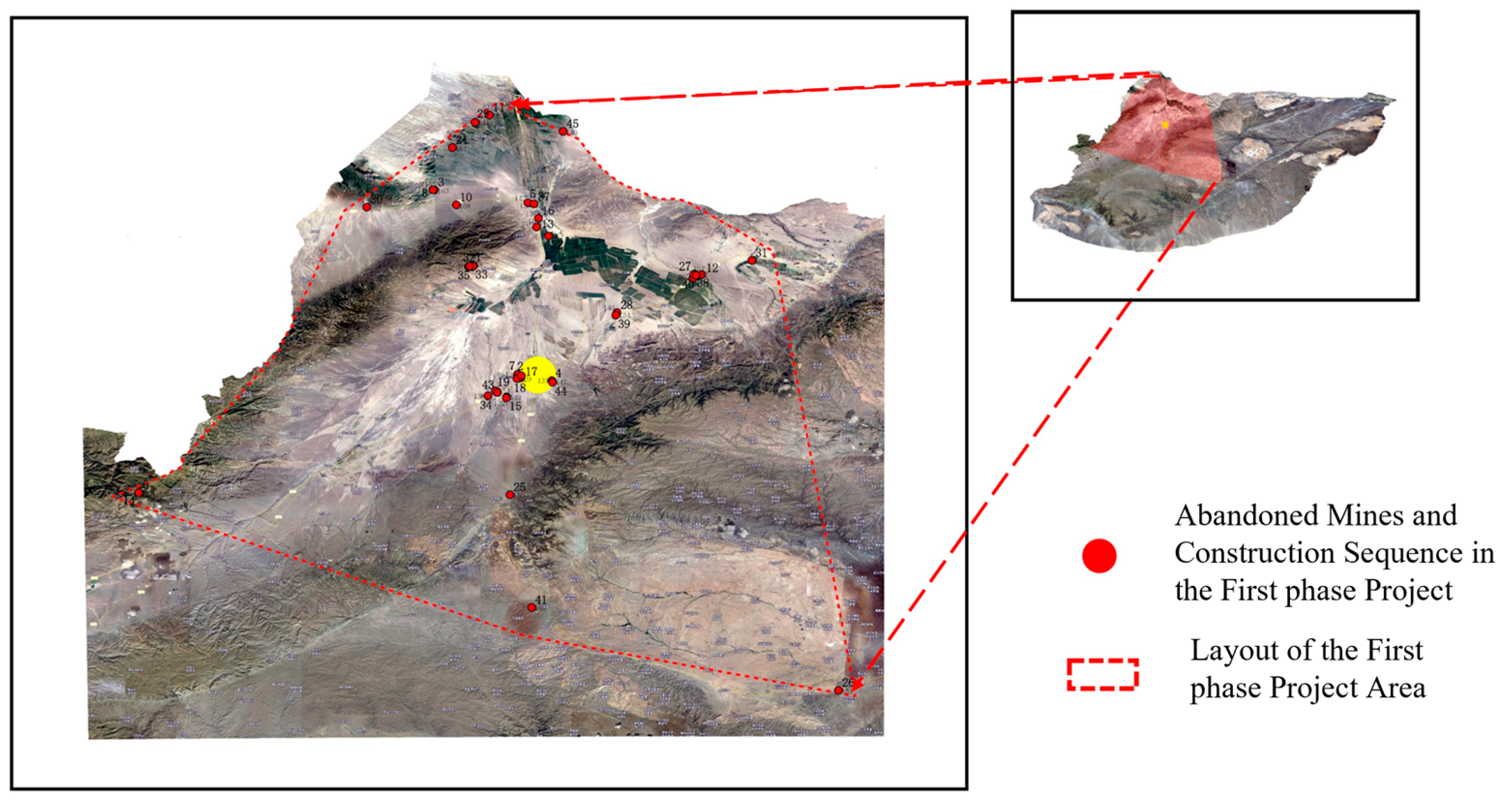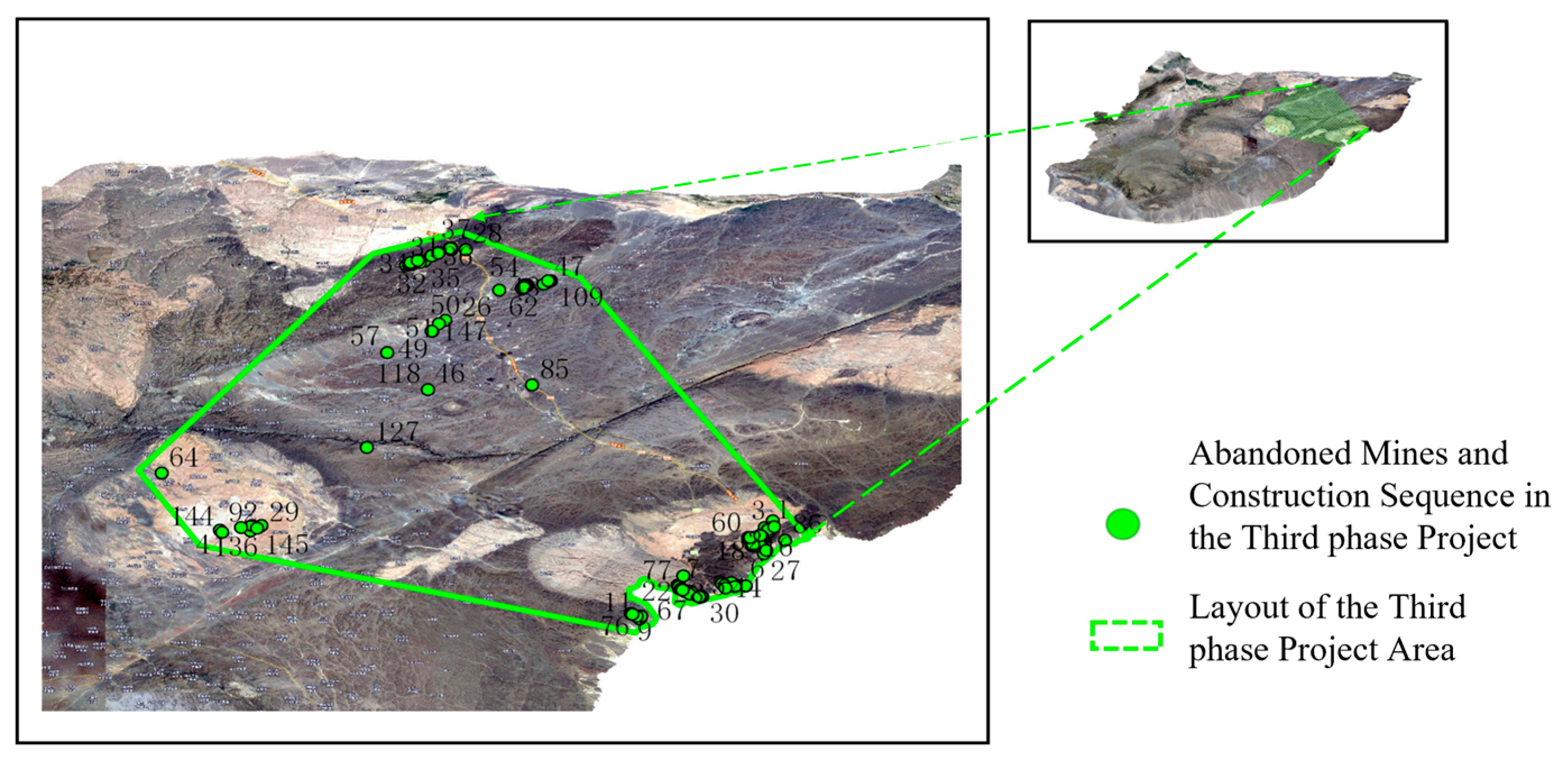3.1. Abandoned Mine Zoning Planning
To facilitate the implementation of future remediation projects, the zoning requirements for abandoned mines necessitated the delineation of areas exhibiting high contiguity and concentrated spatial distributions of abandoned mines earmarked for remediation. Spatial coordinates, specifically longitude and latitude, were selected as evaluation factors due to their direct representation of the spatial distribution of abandoned mines. However, geographically proximate abandoned mines may be separated by natural barriers such as mountains and rivers, potentially impeding the practical execution of remediation efforts. Recognizing the critical role of transportation routes in ensuring mine accessibility, a road index was incorporated as an additional evaluation factor [
59]. The assignment of road index values followed a systematic approach: first, the primary transportation routes within the region were identified and assigned specific values; second, the distances between each abandoned mine and these main roads were measured to determine the nearest road for each mine; finally, the road index value for each mine was defined based on its proximity to the nearest road. This methodology aimed to digitize and differentiate transportation routes, thereby enhancing the meaningfulness and utility of the road indices in the zoning process.
The purpose of assigning values to roadways is to digitize and differentiate roads, while also ensuring that road indicators contribute meaningfully to the clustering and zoning process [
60]. The road value assignment follows a specific rule: roads oriented east–west are assigned odd numbers, with values increasing sequentially from east to west, while roads oriented north–south are assigned even numbers, with values increasing sequentially from north to south. Under this assignment scheme, adjacent or intersecting roads will have minimal value differences, whereas roads with greater spatial separation will exhibit larger value differences, thus optimizing the clustering and zoning outcomes. As illustrated in
Figure 4, taking the roads and abandoned mines shown in the figure as examples: Highway X101 is assigned a value of 1, Highway X102 is assigned a value of 3, Highway X103 is assigned a value of 2, and Highway X104 is assigned a value of 4. Abandoned mine 1, located near Highway X102, is assigned a road indicator value of 3, while abandoned mine 2, located near Highway X101, is assigned a road indicator value of 1.
The standardized results on the longitude [
61], latitude, and road index data for the abandoned mines in Toli County were designated from M001 to Mn (
Table 3).
The final clustering results for standardized basic data of abandoned mines in Toli County with
K = 3 in K-means clustering analysis [
62]. Three abandoned mine zones were identified in Toli County. Zone 1 had abandoned mines, numbered from
Q1 to
Qa. Zone 2 had B abandoned mines, numbered from
M1 to
Mb. Finally, Zone 3 had C abandoned mines, numbered from
N1 to
Nc.
3.2. Abandoned Mine Classification Planning
While the zoning plan successfully categorized abandoned mines in Toli County based on contiguity, it did not specify the management timelines for each zone. To address this limitation, a comprehensive environmental assessment of Toli County was conducted using the hierarchical analysis method, with the degree of impact on human activities serving as the primary evaluation criterion. Based on the results of this zoning analysis, the remediation projects for abandoned mines in Toli County were subsequently delineated into first, second, and third phases.
An evaluation was conducted in Toli County based on the importance of the environmental impact on local inhabitants. Three ecological factors were primarily chosen: topography and geomorphology, vegetation and precipitation, and socio-cultural aspects. The degree of human impact was analyzed through eight secondary factors: elevation, aspect, slope, vegetation index, land use type, precipitation index, population density, and GDP [
63,
64]. The ecological importance hierarchical model of Toli County was subdivided into the following three layers: the decision goal criterion layer, the criterion layer, and the benchmark layer. The decision goal was the final evaluation result; the criterion layer comprised the three ecological factors, and the benchmark layer comprised eight secondary factors under these three ecological factors.
Pairwise comparisons of evaluation factors were conducted based on the degree of impact on humans, assigning values according to expert scoring. The judgment matrices for ecological importance, topography, geomorphology, vegetation, precipitation, and socio-cultural aspects of Toli County were
I1,
I2,
I3, and
I4, respectively, and had the following forms Equations (6)–(9):
The consistency ratios of the four judgment matrices
I1,
I2,
I3, and
I4 were 0.0088, 0.0088, 0.0088, and 0, respectively, all passing the consistency test [
65]. The analysis’s overall hierarchical sorting
CR value was 0.0088, i.e., it passed the consistency test, allowing for calculating weights for the evaluation factors.
By integrating Equations (2)–(4) with Equation (6), the weights of the criteria layer factors were determined to be 0.1061, 0.1929, and 0.7010, respectively. Subsequently, the evaluation indicators within each criterion were calculated for the benchmark layer. By combining Equations (2)–(4) with Equations (7)–(9), the weights of all evaluation factors in the benchmark layer were obtained. Finally, the weights of ecological environmental importance evaluation factors for Toli County were obtained (
Table 4).
After determining the weights of each evaluation factor, the importance of each factor’s impact on humans in Toli County was assessed. Given that different factors vary in their degree of significance to human populations, each factor’s importance was evaluated individually. For example, regarding slope, human activities typically occur in areas with gentler gradients; therefore, regions with lower slopes hold greater significance for human habitation and production. Consequently, the impact of slope on humans is inversely proportional to its numerical value. The zoning principles for each evaluation factor are outlined in (
Table 5).
The remote sensing data for each ecological factor in Toli County were reclassified, and the impact of each category was evaluated and assigned numerical values. To eliminate the influence of dimensionality and enhance the assessment of importance, the data for the eight evaluation factors were categorized into Primary Impact Zones, Secondary Impact Zones, and Tertiary Impact Zones based on a hierarchical evaluation principle. Assigned values of 3, 2, and 1 were allocated to these zones, respectively, with the magnitude of the assigned values being proportional to their degree of importance (
Table 6).
Based on the aforementioned analysis of the importance and weight assignment of the evaluation factors, spatial overlay processing and analytical calculations were conducted on the remote sensing data for the eight assessment factors in Toli County. This process categorized the factors into three distinct classes: Primary Impact Zone, Secondary Impact Zone, and Tertiary Impact Zone. Taking slope as an example, as illustrated in
Table 4, the remote sensing data were reclassified by assigning a value of 3 to slopes between 0 and 5°, a value of 2 to slopes between 5 and 10°, and a value of 1 to slopes exceeding 10°. This reclassification resulted in the zonation map for the slope factor in Toli County (
Figure 5a). Similarly, the remaining factors were reclassified according to their respective levels, thereby producing zoning maps for all eight evaluation factors in Toli County (
Figure 5a–h).
By combining the latter map with the impact weights of each factor and performing grid calculations and overlaying, the comprehensive evaluation map of the ecological importance of Toli County was constructed (
Figure 6). The most significant factors affecting the importance levels of abandoned mine areas in Toli County were the population density, GDP, and vegetation index. The primary Impact Zone in Toli County, influenced by anthropogenic factors like population density and GDP, was mainly located near Toli County City and Tiechanggou Town. Influenced by natural factors such as precipitation, vegetation, and land use, the Secondary Impact Zone was concentrated in the northwestern part of Toli County. Other areas in Toli County with less significant impacts formed the Tertiary Impact Zone, mainly covering the eastern and southern parts of Toli County.
Using mathematical quantitative modeling, the ecological impact importance evaluation system was established for Toli County. The numbers and ratios of importance levels for abandoned mine areas were determined by integrating zone planning, ultimately subdividing the project into three phases. The base map’s remote sensing data is sourced from Maxar Technologies (
Figure 7).
The red area in the figure represents Phase I of the project, the purple area denotes Phase II, and the green area corresponds to Phase III. The rationale for this delineation is as follows:
- (1)
Abandoned Mine Zone 1: This zone is predominantly characterized by primary and secondary ecological impacts in Toli County, significantly affecting both human society and the ecological environment. Consequently, it has been designated as the first phase of the abandoned mine restoration project in Toli County. Priority remediation efforts will focus on the abandoned mines within this area, which is termed the Human Factors-Dominated Ecological Priority Restoration Zone.
- (2)
Abandoned Mine Zone 2: This zone primarily exhibits primary and tertiary impacts in Toli County. It is therefore designated as the second phase of the abandoned mine restoration project. Although this area experiences lower levels of human activity, it benefits from favorable natural conditions such as adequate precipitation and temperature, indicating substantial ecological potential. As a result, abandoned mines within this zone will undergo secondary remediation. This area is named the Climate Factors Dominated Ecological Key Restoration Zone.
- (3)
This zone is mainly characterized by secondary and tertiary impacts in Toli County, posing minimal threats to human society and the natural environment. Additionally, it has limited potential for ecological development. Consequently, it is classified as the third phase of the abandoned mine restoration project in Toli County, with remediation activities scheduled subsequently. This zone is designated as the Topography Factors-Dominated Ecological Routine Restoration Zone.
3.3. Abandoned Mine Grading Planning
The above classification plan outlined the three phases of restoration projects for the abandoned mines in Toli County. However, within each phase, the sequence for restoring multiple abandoned mines still had to be planned. The restoration sequence for abandoned mines within each restoration project was established based on the degree of hazard posed by the mines, using principal component analysis as the grading standard.
In the first phase of the Toli County project, data regarding the distance, land category, area, and ecological indices of abandoned mines were systematically analyzed. Due to policy requirements, the abandoned mines were anonymized and assigned numerical identifiers ranging from
Q001 to
Qa (
Table 7). To mitigate the influence of differing units and ensure comparability, the raw data collected were standardized using the Z-Score normalization method (
Table 6).
PCA was used for data analysis to rank abandoned mines within the project’s first phase. PCA applicability is known to require the Kaiser-Meyer-Olkin (KMO) value of no less than 0.6 and the significance (Sig) of Bartlett’s test of sphericity not exceeding 0.05. The KMO value of this model is 0.613, and Bartlett’s test of sphericity value is 0.0001, both meet the requirements for analysis. The indices of the performed PCA had a good degree of association, allowing for the PCA to be conducted [
66].
Further extract principal components from the total variance with initial eigenvalues greater than 1, calculated as principal components 1 (Y
1) and 2 (Y
2). Together, they accounted for 87.11% of the total variance. (
Table 8) shows the total variance explanation for the PCA [
67].
Consequently, the hazard assessment model for abandoned mines was characterized by Principal Components 1 and 2. To elucidate the coupling relationships between the four evaluation indicators and the hazards associated with abandoned mines, the interactions between these four rating indicators and the principal components were subsequently calculated (
Table 9). A comprehensive score calculation for the principal components was conducted to determine the restoration order of abandoned mines in the severe impact zone, where
X1 represents the ecological index,
X2 is the land category index,
X3 is the distance index, and
X4 is the area index. The weights of the evaluation indices in each principal component were calculated
The corresponding coefficients of each evaluation index were calculated using the data in the component matrix table and the eigenvalues of the corresponding principal components. The following formulas Equations (10) and (11) were used to determine the composite scores for principal components 1 and 2:
Combining various ratios of principal components
Y1 and
Y2, the final comprehensive score
Y for each abandoned mine was derived using Equation (12):
Using the above formulas for each principal component and the data of each index (after preprocessing), the comprehensive scores of principal components 1 (
Y1) and principal component 2 (
Y2) for each abandoned mine, as well as the overall mine score
Y, were obtained. The abandoned mines within the project phase were graded and ranked based on the comprehensive score
Y. The comprehensive scores and grading order of the abandoned mines in phase one of the project (
Table 10).
The grading and ranking of abandoned mines were directly proportional to their threat to human health and the ecological environment, meeting the requirements of grading planning. This approach achieved graded management planning for restoring abandoned mines from ecological safety and functional perspectives. The arrangement of the first phase of the abandoned mine project in Toli County (
Figure 8).
By applying the same methodology, the restoration sequences for abandoned mines exhibiting secondary (
Figure 9) and tertiary (
Figure 10) impacts in Toli County were subsequently determined.
